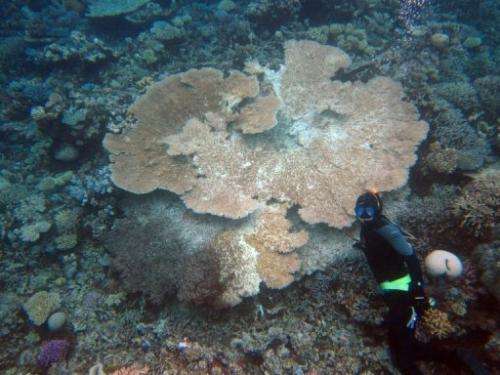Furry crabs may be healing Great Barrier Reef

Furry crabs once thought to be damaging the Great Barrier Reef may in fact be helping save the coral by stopping the spread of disease, a researcher said.
Scientists at James Cook University studied the impact of furry coral crabs on fragments suffering from white syndrome, a deadly disease that appears throughout the Indo-Pacific and causes coral tissue to slough off.
"I think the crabs are helping by consuming that tissue as it falls off and also by eating any of the other associated micro-organisms that could thrive on that dead and dying tissue," researcher Joseph Pollock told AFP.
Pollock said the crabs did not kill the disease, the cause of which is still unknown, but his study showed they significantly slowed its progress.
"It slows it by about three-fold," he said, adding that the disease was often associated with warmer water temperatures.
"It could be that these crabs are giving it (the coral) a bit of a chance to stay alive until potentially those water temperatures could come down or the coral could put up a defence to stop the disease progression itself."
Pollock, from the Queensland university's School of Marine and Tropical Biology, said he had been working on what causes the destructive disease.
"It can kill two-metre, three-metre coral colonies that are decades old in a matter of just months," he said, adding that it was a major threat and sometimes overlooked.
Australia is under growing pressure to step up protection of the Great Barrier Reef, a world heritage site, which has been damaged by the predatory crown-of-thorns starfish.
Conservationists also fear the reef is at risk from a gas and mining boom, resulting in increased coastal run-off and more marine traffic, and coastal development.
Pollock said there were links between white syndrome and factors such as warmer water temperatures and coastal run-off.
He added: "Once a crown-of-thorns starfish comes through, even the parts that are still left alive are still very susceptible to the disease... they are all sort of intertwined together."
Pollock said his study at Lizard Island, about 240 kilometres (150 miles) north of Cairns, involved collecting healthy and diseased coral colonies, adding crabs, and observing the fragments for three weeks.
He said the researchers found the crabs were strongly attracted to colonies hit by white syndrome.
"This means that when a coral is infected with the disease, crabs from nearby coral colonies could migrate to the diseased colony, slowing the disease," he said.
"This could be a very interesting feedback mechanism whereby these crabs help to slow coral disease on reefs."
(c) 2013 AFP
















